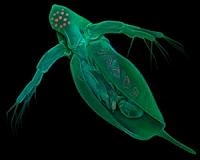| . |  |
. |
Boulder CO (SPX) Feb 07, 2011 The aggressive wolverine may not be powerful enough to survive climate change in the contiguous United States, new research concludes. Wolverine habitat in the northwestern United States is likely to warm dramatically if society continues to emit large amounts of greenhouse gases, according to new computer model simulations carried out at the National Center for Atmospheric Research (NCAR). The study found that climate change is likely to imperil the wolverine in two ways: reducing or eliminating the springtime snow cover that wolverines rely on to protect and shelter newborn kits, and increasing August temperatures well beyond what the species may be able to tolerate. "Species that depend on snow cover for their survival are likely to be very vulnerable to climate change," says NCAR scientist Synte Peacock, the author of the study. "It's highly uncertain whether wolverines will continue to survive in the lower 48, given the changes that are likely to take place there." Peacock's research focused on mountainous regions of the Northwest, the primary habitat of the wolverine population in the contiguous United States. The study did not look into the impacts of climate change on regions where wolverines are more numerous, such as Canada, although other research has indicated those areas will likely warm significantly as well. The study was published last week in Environmental Research Letters. It was funded by the National Science Foundation, NCAR's sponsor.
An animal built for the cold While some 15,000 or more wolverines are believed to roam Canada and an unknown number in Alaska, only a few dozen to a few hundred are believed to live in the contiguous United States, almost entirely in mountainous areas in Wyoming, Idaho, Montana, and Washington. Wolverines inhabit regions that have late-season snow cover and relatively cool summer temperatures. Female wolverines make their springtime dens in the snow, which provides warmth to the newborn kits and protects them from predators. Biologists are dubious that the species could survive in regions with little spring snow or significantly higher summertime temperatures. Concerned over habitat loss and the potential threat of climate change, the U.S. Fish and Wildlife Service announced in December 2010 that the wolverine warrants protection under the Endangered Species Act, but delayed that protection because other species took higher priority. To project the future climate in regions of the contiguous United States where wolverines live, Peacock analyzed results from new simulations carried out by a team of researchers at NCAR using the newest version of the Community Climate System Model (which was developed by scientists at the Department of Energy and NCAR with colleagues at other organizations). She analyzed three scenarios of greenhouse gas emissions: low (carbon dioxide emissions stay at present-day levels until 2020 and then decline to zero by the early 2080s); medium-low (emissions rise slightly until 2040 and then decline sharply toward the end of the century); and high (emissions continue to increase unabated). In the high emissions scenario, the computer simulations showed spring snow cover nearly or completely vanishing during the second half of this century in present-day wolverine habitat. Similarly, spring snow cover in the medium-low scenario became greatly diminished, with many years experiencing zero snow cover. Under the low emissions scenario, springtime snow cover conditions remained similar to those of the present day. The computer projections also showed that August temperatures may increase dramatically. Whereas August temperatures currently top off at about 72 degrees F (22 degrees C) in areas where wolverines live, maximum daily temperatures by the end of the century were projected to frequently exceed 90 degrees F (32 degrees C) under the two higher-emissions scenarios. "Unless the wolverine is able to very rapidly adapt to summertime temperatures far above anything it currently experiences, and to a spring with little or no snow cover, it is unlikely that it will continue to survive in the contiguous U.S. under a high or medium-low emissions scenario," the study concludes. The model simulations also indicated the extent to which climate change may transform the West, where society depends on mountain snowpack. This critical source of water could decrease by a factor of three to four over Idaho, western Montana, and western Wyoming by the end of this century under the high emissions scenario. Even under the medium-low emissions scenario, snowpack could drop by a factor of two to three in these regions. Peacock checked the accuracy of the model by comparing simulations of late 20th century climate with observations. Results indicated that the model did a good job simulating climate conditions in Idaho, Montana, and Wyoming. Since the model tended to underestimate snowpack in Washington, Peacock did not include that state in the study.
Share This Article With Planet Earth
Related Links UCAR Darwin Today At TerraDaily.com
 First Crustacean Genome Is Sequenced
First Crustacean Genome Is SequencedWoods Hole MA (SPX) Feb 07, 2011 The ubiquitous freshwater "water flea," Daphnia pulex, may be too small to see, but it has amply proven its value as an "sentinel species" for the presence of toxins and pollutants in the environment. Daphnia's response to exposure to toxic metals and other chemical pollutants is well studied, and this information is routinely used by groups such as the US Environmental Protection Agency ( ... read more |
|
| The content herein, unless otherwise known to be public domain, are Copyright 1995-2010 - SpaceDaily. AFP and UPI Wire Stories are copyright Agence France-Presse and United Press International. ESA Portal Reports are copyright European Space Agency. All NASA sourced material is public domain. Additional copyrights may apply in whole or part to other bona fide parties. Advertising does not imply endorsement,agreement or approval of any opinions, statements or information provided by SpaceDaily on any Web page published or hosted by SpaceDaily. Privacy Statement |